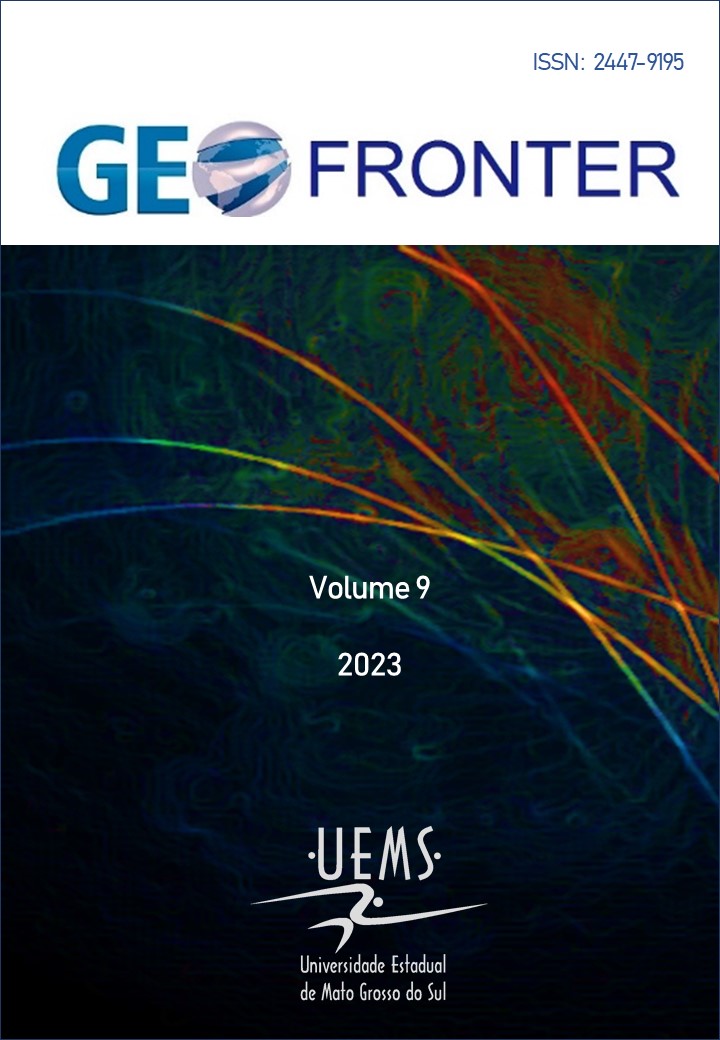PROJETO EDUCASOLOS: O MACROPEDOLITO COMO FORMA DIDÁTICA DE SE TRABALHAR A EDUCAÇÃO AMBIENTAL E O ENSINO DE SOLOS
DOI:
https://doi.org/10.61389/geofronter.v9i1.7617Palabras clave:
Macropedolito, Ensino, Solos, Educação Ambiental, Material DidáticoResumen
El propósito de este artículo es demostrar la importancia de utilizar el macropedolito y otros materiales didácticos hecho de suelos encontrado en el municipio de Ituiutaba/MG, con el objetivo de sensibilizar al público seleccionado, además de contribuir en el cambio de concepción y actitud de los alumnos, promover experiencias que puedan cooperar en la construcción de un conocimiento en los suelos. Para eso, Los procedimientos metodológicos utilizados fueron: Investigación y revisión bibliográfica sobre el tema en análisis; Trabajo de campo para reconocimiento y toma de muestras de suelo; Elaboración de instrumentos didácticos para hacer las conferencias más lúdicas e interactivas. El uso de macropedolitos en las visitas al laboratorio docente de la universidad despertó la curiosidad de estudiantes y docentes que tenían poco conocimiento de las características del suelo del municipio de Ituiutaba/MG. Así, fue posible trabajar aspectos teóricos y metodológicos de los suelos y aproximar este conocimiento a través de la experimentación, en el que los estudiantes podían participar en conferencias dialogadas, fazer reflexões sobre a forma como a sociedade tem se relacionado com a natureza, que en este caso estuvo representada por los suelos. Los alumnos pudieron observar las diferencias entre los perfiles de Latossolo, Gleissolo y Nitossolo, texturizaron las muestras, observaron colores, entre otros. Así, se espera que el proyecto EducaSolos pueda llevar a más alumnos al laboratorio de enseñanza, tener un momento de experimentación, y podrá contribuir para la divulgación del conocimiento sobre suelos en el municipio de Ituiutaba/MG.
Citas
BRASIL. MINISTÉRIO DO MEIO AMBIENTE. Lei nº 9.795, de 27 de abril de 1999. Diário Oficial da União, Brasília, 2000.
EMBRAPA. Centro Nacional de Pesquisa de Solos. Sistema Brasileiro de Classificação de Solos. 5 ed. Brasília: Embrapa, 2018. 356p.
EMPRESA BRASILEIRA DE PESQUISA AGROPECUÁRIA. Centro Nacional de Pesquisa de Solos. Manual de métodos de análise de solos. 2. ed. Rio de Janeiro, 1997. 212 p.
FALCÃO, C. L. da C.; SOBRINHO, J. F. Material educativo sobre educação do solo: da produção acadêmica às ações de extensão na educação básica. GEOPAUTA, v. 5, n. 1, p. 1-22, 2021. Disponível em: https://periodicos2.uesb.br/index.php/geo/article/download/7008/5667/21653. Acesso em: 25/05/2023.
FAO (FOOD AND AGRICULTURE ORGANIZATION OF THE UNITED NATIONS). La erosion del suelo por el água: algunas medidas para combatirla em las tierras de cultivo. Roma: FAO, 1967, 207 p.
FREIRE, O. Solos das regiões tropicais. Botucatu. FEPAF, 2006.
GONÇALVES, C.W.P. Possibilidade e limites da ciência e da técnica diante da questão
ambiental. In: Seminários Universidade e Meio Ambiente - Documentos Básicos.
Brasília: IBAMA, 1990.
GUERRA, A.T.; GUERRA, A. J. T. Novo dicionário geológico-geomorfológico. Rio de Janeiro: Bertrand Brasil, 1997, 652p.
LANDIM NETO, F. O., MENDES, J. S.; RABELO, F. B. D.; SILVA, E. V.; GORAYEB, A. Educação Ambiental e Extensão Universitária: conservação e preservação dos recursos naturais da comunidade de Mundaú-Trairi/Ceará. Revista Extensão em Ação. V. 3, n. 1, jan/jun, 2013. Disponível em: https://repositorio.ufc.br/handle/riufc/13288 Acesso: 01/03/2023.
LEPSCH, I. F. Formação e Conservação dos Solos. 2. ed. São Paulo: Oficina de textos, 2010. 216 p.
LOUREIRO, C. F. B. O movimento ambientalista e o pensamento crítico: uma abordagem política. Rio de Janeiro. Quarter, 2003, 160p.
MARTINS, F. P.; COSTA, R. A. A Compartimentação do relevo como subsídio aos estudos ambientais no município de Ituiutaba-MG. Revista Sociedade e Natureza. v. 26. n. 2. Uberlândia, 2014. p. 317-331. DOI: https://doi.org/10.1590/1982-451320140209
MUGGLER, C. C.; SOBRINHO, F. de A. P. Educação em solos: princípios, teoria e métodos. Revista Brasileira de Ciências do Solo. N. 30, 2006, p. 733-740; Disponível: https://www.scielo.br/j/rbcs/a/Nm8pcwCzY4dh87dzkzQKQ9z/abstract/?lang=pt Acesso: 02/04/2023. DOI: https://doi.org/10.1590/S0100-06832006000400014
NUNES, J. O. R. et al (org.). Trilhando pelos solos. Presidente Prudente: Copy Set, 2010. 33 p. Disponível em: https://labsolos.wixsite.com/labsolos/publicacoes Acesso: 05/05/2023.
PEDRO, L. C. A Geografia “Física” no ensino fundamental: um relato sobre a importância dos conteúdos e das atividades práticas na formação do aluno. Revista Geografia em Atos, Presidente Prudente, v. 1, n. 11, p.,3857, jan. 2011. Disponível em: https://revista.fct.unesp.br/index.php/geografiaematos/article/view/416 Acesso: 11/05/2023.
PEDRO MIYAZAKI, L. C. Projeto EducaSolos: práticas lúdicas e pedagógicas aplicadas ao ensino dos solos. Dinâmicas naturais e humanas nos ambientes urbanos. Editora Compasso, Porto Alegre, 2022. Disponível em: https://labsolos.wixsite.com/labsolos/publicacoes Acesso: 23/03/2023. DOI: https://doi.org/10.29327/554448.1-12
Ruelan A., Dosso M. Regards sur le sol. Paris. Les Éditions Foucher. 192 p., 1993.
SANTOS, H.G. et. al. Sistema brasileiro de classificação de solos. 2 ed. Rio de Janeiro: Embrapa Solos, 2006.
TEIXEIRA, A. C. Educação Ambiental: caminho para a sustentabilidade. Revista Brasileiro de educação Ambiental, Brasília, nº 02. Rede Brasileira de Educação Ambiental, 2007.
Descargas
Publicado
Cómo citar
Número
Sección
Licencia

Esta obra está bajo una licencia internacional Creative Commons Atribución-NoComercial-SinDerivadas 4.0.
Os autores concedem à revista GEFRONTER os direitos autorais sobre o texto aceito para publicação. Autorizações especiais podem ser concedidas mediante aceite do editor do periódico.

